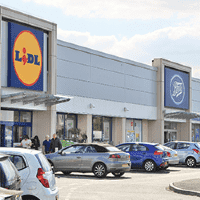The evidence suggests an attitude change has accounted for the growth of the OOT Value retail market, not only for the consumer but for other occupiers and for landlords in tenant selection. As Value retailers across all sectors have grown their portfolio’s their covenants have become some of the strongest on offer, often taking longer leases than many other traditional OOT retailers, hence the strong appeal from a landlord perspective. Unsurprisingly other types of Value retailer are also increasingly attracted to parks containing one of the Value grocery brands. Home Bargains for example has 76 stores on parks anchored by Aldi, Lidl, Iceland or Farmfoods. Six years ago, that figure was 32.
Consumers, adjacent occupiers and landlords all benefit from growth
.png)
FIGURE 7Growth of OOT schemes containing a Value grocer and key OOT retailer
Source: Savills Research, Geolytix
Crucially however, some more upmarket brands, such as Marks & Spencer and Next, are also increasingly finding themselves located alongside Value grocers. For example, M&S, which currently has 23 stores located adjacent to Value grocery retail brands, had only nine back in 2011. Next’s adjacency to Value grocery has grown from 14 schemes in 2011 to 22 currently. This trend is linked to the way Value grocery retailers have sought to appeal to more affluent shoppers.
Perceptions of Value retailers have changed among landlords and developers as well as shoppers. This is highlighted by a growing number of non-discount brands, such as M&S and Next, who are increasingly finding themselves sitting alongside them on OOT schemes; brands are far more accepting of these adjacencies than they may have been a decade ago. Value orientated retailers will continue to seek out space on OOT schemes in both the food and nonfood sector, fuelling the demand for the OOT development pipeline.
The same is true in the Value Comparison Goods market. In 2011 Marks & Spencer had 20 stores on the same scheme as one or more of the Value Comparison Goods operators analysed. Today this has grown to 95, representing a 375% increase. Next have gone from 48 to 125, representing a 160% increase.
.png)
FIGURE 8Growth of OOT schemes containing a Value fashion retailer and key OOT retailer
Source: Savills Research, Geolytix
The benefit of Value retailers locating adjacent to such mainstream brands from other sectors is not lost in the Comparison Goods market as retailers look to gain access to a customer base that spans all demographic groups. In the Value fashion market Matalan has increased adjacency to one or more of the Comparison Goods retailers by 143% sharing retail space on 90 schemes, from 37 in 2011. Aldi had 27 stores on schemes with a Value Comparison Goods operator in 2011. It now has 73, an increase of 170%.
.png)
FIGURE 9Growth of OOT schemes containing a Value Comparison Goods operator and key OOT retailer
Source: Savills Research, Geolytix
Value fashion retailers have not been as prevalent in taking space next to Aldi and Lidl, where portfolio growth has been greatest on smaller schemes below 40,000 sq ft. What is more important to Value fashion brands is being located on larger fashion parks, of over 100,000 sq ft, next to some of the traditional more aspirational fashion retailers with larger units. M&S has 117 stores alongside one or more of the Value fashion retailers for example, double that of six years ago. Next exposure to Value fashion brands on the other hand has increased from 154 schemes to 189 in the same period.



.png)